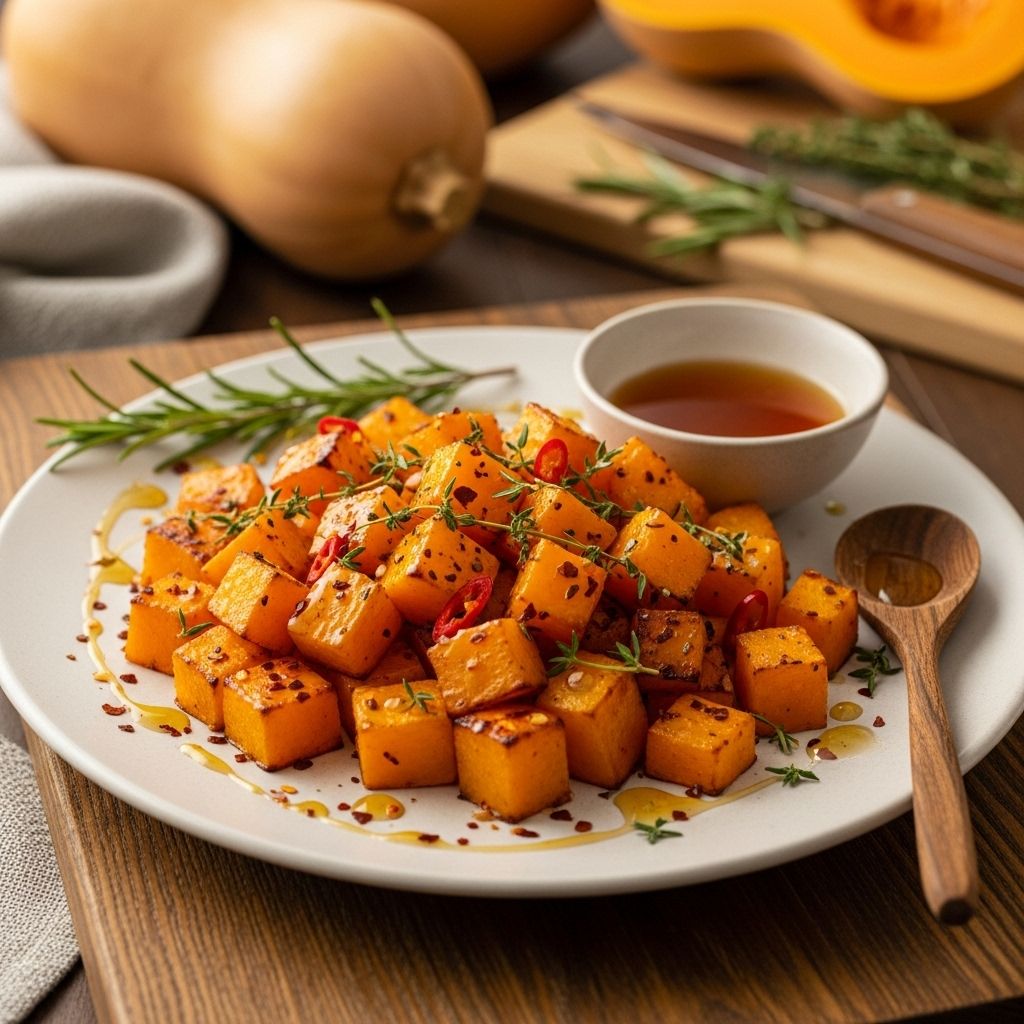Baked Butternut Squash Recipe: 5 Easy Steps For Perfect Flavor
Discover how to prepare and bake butternut squash with ease for a healthy, flavorful, and satisfying side dish perfect for any occasion.

Image: HearthJunction Design Team
Perfect Baked Butternut Squash: Simple, Delicious, and Nutritious
Baked butternut squash is a staple side dish that requires minimal ingredients but delivers maximum flavor and nutrition. With its sweet, creamy texture and beautiful orange hue, this dish makes a perfect addition to any meal—whether you’re serving a holiday feast or a casual weeknight dinner. This comprehensive guide will walk you through everything you need to know: from selecting a squash to serving suggestions, nutritional information, and more.
What You’ll Need
For a classic baked butternut squash—like the one beloved in families for generations—you only need a handful of readily available ingredients. Here’s a quick overview:
- 1 butternut squash (medium to large, firm, and heavy for its size)
- Butter (unsalted or salted, use according to preference)
- Salt (to taste)
- Black pepper (freshly cracked for best flavor)
- Optional sweetener: brown sugar or maple syrup for extra richness
- Water (for baking dish, helps steam the squash)
Step-by-Step Instructions
1. Preheat the Oven
Set your oven to 350°F (175°C). Make sure the oven rack is placed in the center position for even baking.
2. Prepare the Butternut Squash
- Wash the exterior thoroughly to remove any dirt.
- Using a sharp chef’s knife, carefully slice the butternut squash in half lengthwise. A large, stable cutting board and slow, steady pressure provide the safest cut.
- Scoop out the seeds and stringy pulp using a spoon. (You can save the seeds for roasting, much like pumpkin seeds, for a crunchy snack!)
3. Season the Squash
- Place the squash halves, cut side up, in a large baking dish.
- Drop a tablespoon of butter into the cavity of each half. For added sweetness, you can sprinkle a little brown sugar or drizzle maple syrup inside as well.
- Season with salt and pepper to taste.
- Pour two cups of water into the bottom of the baking dish. This step is important—the water helps generate steam, ensuring the squash bakes up moist and tender.
4. Bake Until Tender
- Carefully cover the baking dish with aluminum foil to trap in moisture. (Optional, but helps ensure a softer result.)
- Bake the squash for about 60 minutes.
- Check for doneness: The squash is ready when a fork easily pierces the thickest part. Larger squash may require up to 75 minutes.
5. Serve and Enjoy
- Once baked, remove the squash from the oven and let it cool slightly.
- Top with a little more butter or your favorite finishing touch: a sprinkle of cinnamon, nutmeg, or extra brown sugar.
- Scoop out the flesh and mash gently for a rustic presentation, or slice and serve as wedges.
Tips for the Best Baked Butternut Squash
- Uniformity: If baking multiple squash, try to select similar-sized halves for even cooking.
- Extra flavor: Herbs such as thyme or rosemary, minced garlic, or a hint of chili flakes add depth to the dish.
- Texture options: Bake the squash uncovered for caramelized, slightly crispy edges. Cover with foil for a softer texture.
- Easy clean-up: Line your baking dish with parchment paper or foil to make cleaning a breeze.
- Leftovers: Scoop and store leftover squash in an airtight container in the refrigerator for up to four days. Use in soups, salads, or even on toast!
Variations
- Sweet Cinnamon Squash: Replace pepper with cinnamon and add a drizzle of maple syrup before baking.
- Savory Herb Squash: Add chopped thyme, rosemary, or sage and a dash of olive oil in place of butter.
- Cheesy Baked Squash: Sprinkle freshly grated Parmesan cheese on top during the last five minutes of baking.
- Stuffed Squash: Hollow a little more from the cavity and fill with a stuffing of breadcrumbs, nuts, dried fruit, and cheese before baking.
Serving Suggestions
- Serve alongside roasted meats, poultry, or as a warm, hearty vegetarian main when topped with toasted nuts and greens.
- Add to grain bowls, toss with salads, or blend into creamy butternut squash soup.
- Use as a filling for ravioli or gnocchi for a homemade pasta night.
Nutrition Information
Butternut squash offers a powerhouse of nutrition. Here’s a breakdown per typical serving (about 1 cup baked squash):
- Calories: 63
- Total Fat: 0.1g (without butter)
- Sodium: 6mg
- Total Carbohydrates: 16g
- Dietary Fiber: 3g
- Sugars: 3g
- Protein: 1g
- Rich in: Vitamin A, Vitamin C, potassium, and magnesium
Table: Quick Reference for Baked Butternut Squash
| Step | Description | Tips |
|---|---|---|
| Preparation | Wash and halve the squash, scoop seeds | Use a sturdy knife for safety |
| Season | Add butter, salt, pepper (plus optional sugar or syrup) | Customize with herbs or spices |
| Baking | 350°F for ~60 minutes with water in pan | Foil optional, test with a fork |
| Serving | Mash, slice, or scoop out flesh | Add toppings as desired |
Frequently Asked Questions (FAQs)
Can I prepare baked butternut squash in advance?
Yes. You can prep the squash (halve and seed) up to a day ahead, storing it tightly wrapped in the fridge. Baked squash can be reheated in the oven or microwave before serving.
Do I need to peel the squash before baking?
No need to peel if you are baking the squash in halves. The flesh scoops easily from the skin when baked. If you plan to cube and roast the squash, peel with a vegetable peeler beforehand.
How do I store leftovers?
Cool baked squash to room temperature, then store covered in the refrigerator. It stays fresh for up to four days. You can freeze the pureed flesh for up to three months.
Can I use this method for other types of squash?
Absolutely. Acorn, kabocha, or even delicata squash can be baked using the same process, though cooking times may vary slightly depending on size and density.
What are some good flavor pairings?
Butternut squash pairs beautifully with cinnamon, nutmeg, maple syrup, fresh herbs (thyme, sage, rosemary), garlic, Parmesan cheese, and toasted nuts such as pecans or walnuts.
Expert Tips for Success
- Knife safety: If your squash is difficult to cut, microwave it for 2–3 minutes to soften just enough for slicing.
- Don’t skip the water: Adding water to the baking dish ensures the squash doesn’t dry out—it steams and bakes at the same time.
- Getting adventurous: Experiment with different spices, drizzles of balsamic reduction, or a sprinkle of crumbly feta or goat cheese for a twist.
Storage and Reheating
Store any leftovers in an airtight container in the refrigerator for up to four days. Reheat in a microwave-safe dish or briefly in the oven at 350°F until warmed through. For longer storage, mash or puree the squash and freeze in airtight containers for up to three months; thaw overnight in the refrigerator before reheating.
Delicious Recipe Variations from the Allrecipes Community
- Simple Roasted Butternut Squash: Peel and cube the squash, toss with olive oil, salt, pepper, and garlic, and roast at 400°F for about 25–35 minutes until golden and fork tender.
- Baked Butternut Squash with Garlic & Cheese: Bake halves, then top with garlic and Parmesan cheese for a savory, cheesy finish.
- Rosemary Roasted Butternut Squash: Cube squash, toss with rosemary, garlic, and olive oil, then roast at 400°F until fragrant and golden.
Conclusion
Baked butternut squash is as easy as it is satisfying. Whether you serve it simply with butter and salt or dress it up with herbs, spices, and cheese, this fall favorite brings both comfort and nutrition to your table. Versatile, affordable, and endlessly adaptable, it’s a go-to side dish that everyone should learn to master. Try the recipe, experiment with flavors, and make it your own!
References
- https://www.allrecipes.com/recipe/229733/simple-roasted-butternut-squash/
- https://www.allrecipes.com/recipe/159433/baked-butternut-squash/
- https://www.allrecipes.com/recipe/230060/savory-roasted-butternut-squash/
- https://www.allrecipes.com/recipe/265903/baked-butternut-squash-with-garlic-and-cheese/
- https://www.allrecipes.com/recipe/230059/rosemary-roasted-butternut-squash/
Read full bio of Anjali Sayee












